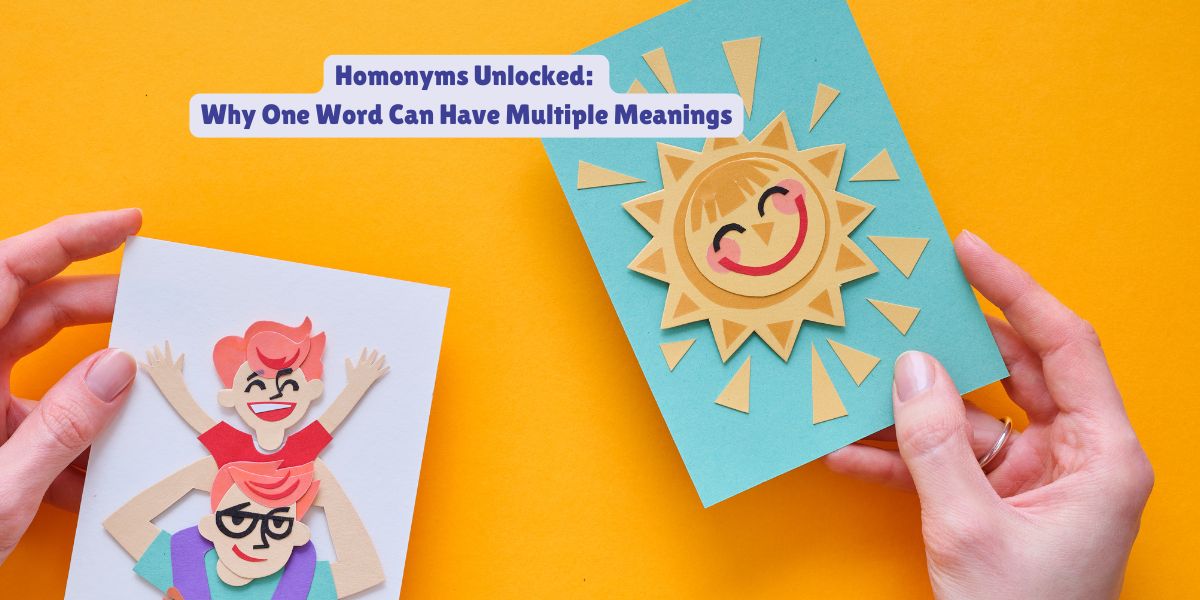
Homonyms Unlocked: Why One Word Can Have Multiple Meanings
Homonyms Unlocked: Why One Word Can Have Multiple Meanings
- By Janaki K. B
The Strange World of Words
Ever wondered why bat can mean both a flying creature and a cricket tool? Or why bank refers to a financial institution and the side of a river? Language is full of these oddities, and they aren’t just quirks—they have a history, a logic, and a real impact on how we communicate. Understanding homonyms isn’t just for linguists; it’s useful for students, parents, and professionals alike!
What Are Homonyms?
Homonyms are words that share the same spelling or pronunciation but have different meanings. They come in two main types:
- Homophones – Words that sound the same but have different meanings and spellings (flour and flower).
- Homographs – Words that are spelled the same but have different meanings and pronunciations (lead as in a metal vs. lead as in guiding someone).
Why Do Words Have Multiple Meanings?
1. Evolution of Language
Language changes constantly. Over centuries, words take on new meanings due to cultural shifts. The word text once referred only to written words, but now it includes messages sent on phones.
2. Borrowing from Other Languages
English has absorbed words from Latin, French, and German. Sometimes, a single word came from different sources but merged into one spelling. For example, date comes from both Latin (datum, meaning “given”) and Arabic (dāq, referring to fruit).
3. Metaphorical Usage
A word’s meaning often expands through metaphor. The mouse on your computer is named after the small rodent because of its shape and movement.
4. Context and Usage Changes
Sometimes, words shift based on how they are used in daily life. Run originally meant physical movement, but now we “run a business,” “run a program,” or “run out of milk.”
The Impact of Homonyms on Learning
For students, homonyms can be confusing. Misinterpreting a word changes the meaning of a sentence entirely. Parents can help children by encouraging reading and discussing word meanings in different contexts.
For professionals, especially writers and speakers, homonyms demand precision. Misusing compliment and complement in a formal email? That can be embarrassing!
How Parents Can Teach Homonyms to Students
1. Use Real-Life Examples
Point out homonyms in daily conversations. For example, when at a bank, explain that the word also refers to a riverbank. When using a bat for a game, mention that it also means a flying creature. This approach makes homonyms more relatable and easier to remember.
2. Play Word Games
✔ Homonym Matching: Write different meanings of homonyms on cards and have kids match them.
✔ Crossword Puzzles & Word Searches: These improve word recognition.
✔ Pictionary: Let kids draw different meanings of the same word.
✔ Homonym Bingo: Create bingo cards with different homonyms, and when a word is called, the child must identify its meaning.
3. Read Stories with Homonyms
Choose books with playful language. Encourage children to underline words with multiple meanings and discuss them. Example: “The bat flew in the night” vs. “He hit the ball with a bat.”
Reading aloud together and discussing tricky words can boost vocabulary and comprehension.
4. Create Sentences Together
Ask your child to create sentences using homonyms. Example:
- “The right answer is on the right side of the page.”
- “Can you watch the baby while I get my watch?”
Encourage them to make up funny sentences to make learning more fun.
5. Use Fun Mnemonics & Rhymes
Turn homonyms into catchy rhymes or songs. This helps kids remember different meanings quickly. For example, for pair and pear, you can say:
“A pair of shoes, a juicy pear,
One to wear, one to share!”
6. Encourage Writing Exercises
Let kids write short stories where one word is used in different ways. For example, a story about a bark that refers to both a tree and a dog’s sound. This not only strengthens their understanding of homonyms but also enhances their creative writing skills.
7. Interactive Quizzes & Online Apps
Use educational apps like Duolingo, Quizlet, or word association games to reinforce learning. Websites such as Funbrain and Vocabulary.com offer engaging homonym-based quizzes that help solidify understanding.
By making homonyms a natural part of conversations, reading, and playtime, parents can help children grasp these tricky words effortlessly!
How to Master Homonyms
✔ Read Widely: Encounter words in different contexts. Newspapers, books, and professional articles expand understanding.
✔ Use a Dictionary: Even native speakers get confused. Looking up meanings helps clarify.
✔ Practice with Word Games: Crossword puzzles and apps like Scrabble boost vocabulary.
✔ Teach Through Examples: Parents and teachers can create sentences that highlight different meanings.
✔ Encourage Curiosity: Ask children why they think a word has multiple meanings and explore its origin together.
✔ Make It a Daily Challenge: Have a “homonym of the day” and see how many ways it can be used.
Final Thoughts
Homonyms make English fascinating but tricky. They show how language grows, adapts, and reflects culture. Mastering them isn’t just about memorizing definitions—it’s about understanding how words work. The next time you hear a homonym, take a moment to think about its journey. Who knows? You might just see words in a whole new way!



